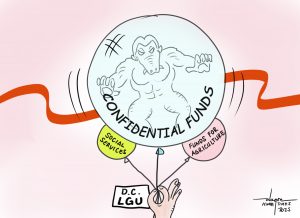 LAST Wednesday we had a short but fruitful chat over Messenger with Councilor Pilar Braga who is Chairman of the Board of the Davao Historical Society (DHS). We too, were once member of the board but we are a negligent one. No, not because we are that kind of person but because the over two years of the CoVid 19 Pandemic forced us to retreat to our farm resident in an upland barangay over 30 kilometers away from the city proper.
LAST Wednesday we had a short but fruitful chat over Messenger with Councilor Pilar Braga who is Chairman of the Board of the Davao Historical Society (DHS). We too, were once member of the board but we are a negligent one. No, not because we are that kind of person but because the over two years of the CoVid 19 Pandemic forced us to retreat to our farm resident in an upland barangay over 30 kilometers away from the city proper.
We sort of “exile” ourselves even though our “hibernation” is in compliance with movement restrictions for health purposes. Adding to our unwillingness to come to the downtown area is the very costly fuel to run our transportation. On average, we have to shell out P1,000.00 for fuel in a round trip including budget for food and snacks while in the city proper. In other words, a frequent trip to the city proper is not economically viable for us considering our present family income. So, we reiterated to Councilor Braga that we have to beg off from active participation in the DHS board activities. We are truly sorry for our undesirable demeanor.
Anyhow, during our chat with the lady dad, we mentioned to her one possible good project of the society which may help enhance the Davaoenos’ knowledge of the history of the city and the once undivided Davao. We told Madam Braga of a volume of documents well kept by the Catholic Church that chronicled the start of the Christianization of Davao and eventually the whole of Mindanao. Other than the religious aspect contained in the documents, we were told, the volumes also recorded the evolution of the place into what it was up to the coming of the Americans.
We came to know about these documents when the late Fr. Paul Cunanan and later the late Nong Noning Lizada, approached us while we were working with the Aboitiz-owned Davao Light and Power Co (DLPC) as its Corporate Social Responsibility (CSR) Department Head. They sought our assistance in reaching out to the Aboitiz executives who they want to help the Church in microfilming the century-old manuscripts.
But according to the late San Lorenzo Ruiz Parish Priest Fr. Paul, he was advised by some “experts” to be extra careful in doing their plan should they get the help of the corporate executives. As revealed by the departed priest, the documents were – and still are – kept in a safe devoid of oxygen. The possibility, according to the late Fr. Paul, is that once exposed outside, the document could immediately disintegrate. Or if not, the papers may have already been so brittle that even touching the pages could destroy it. Of course that was what the so-called “experts” told the priest, which advice was later on shared by the friar to the late Mr. Lizada.
From there, there was some kind of hesitation from the two to pursue their desired meeting with the Aboitiz executives based in Davao City for an initial proposal. The “lull” allowed the untimely death of Fr. Paul, and later of Nong Noning, to overtake the desired courtesy meeting with the corporate officials.
With this knowledge of ours of the existence of such important documents that could further improve our knowledge of the past of our city and the Davao Region, we shared it to Councilor Braga.
We believe that if the DHS will be able to get its hand on the documents and pry over what are those important aspects of the then Davao’s history still unwritten in our history books, the organization will be doing a great service to the present and future generations of Davaoenos. Also, if the DHS will be able to have each and every page microfilmed to ensure that none of those will be turned to shreds, the better.
First and foremost however, we recommended to the DHS chair to have the existence of the history-laden documents confirmed by the Church authorities. Based on what the late Fr. Paul told us, the safe where the documents are stacked for more than a century already is hidden in an underground space where its top is the belfry of a well-known Davao Church.
So, as an initial move we recommended to Madam Pilar to write to the Archbishop of Davao Monsignor Romulo Valles, DD, to inquire about the important documents.


